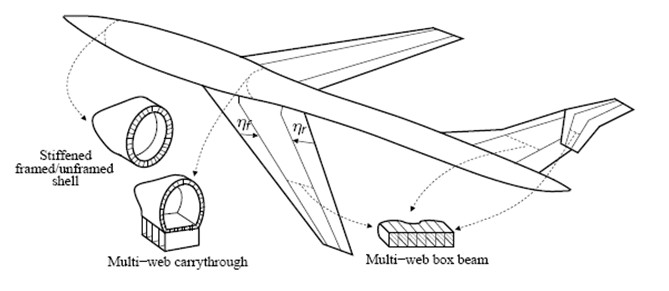GUESS is used to refine the weight prediction described in the previous section and to give a first estimation for stiffness and load-bearing material distribution. Once this is available, a stick beam model is automatically generated to be used by the numerical aerostructural module SMARTCAD that will be described next. Fundamental structural principles, such as continuous mechanics and equation of beams subject to bending, shear and torsion are adopted by GUESS to estimate the load-bearing airframe of fuselage and lifting surfaces.
This is particularly useful in the aircraft conceptual design because it represents a compromise between the rapid assessment of component weight using empirical methods, based on actual weights of existing aircraft, and detailed but time-consuming finite-element analysis. Both methods have particular advantages but also limitations, which does not make them completely suitable for the conceptual design phase.
GUESS starts from the approach presented in Ref. [1] for fuselage and wing-box sizing and further extends it to the sizing of the horizontal and vertical tailplanes to have a complete view of the airframe for the whole aircraft. Recently new structural typologies have been introduced specifically for lifting surfaces.

Structural models adopted for different aircraft component.
The distribution of loads and vehicle geometry are accounted for because the analysis is done station-by-station along the vehicle longitudinal axis and along the lifting surface structural chord, giving an integrated weight that depends on local conditions. Nevertheless, an analysis based solely on fundamental principles will give an accurate estimate of structural weight only. Thus, weights for the secondary structures of the fuselage and the lifting surfaces (including leading- and trailing-edge control surfaces) and items from primary structure (such as doublers, cutouts and fasteners) must be estimated through a correlation with existing aircraft.
GUESS determines the distribution of the stiffness and the nonstructural mass of the airframe subjected to different types of maneuvers, such as pull-up at prescribed normal load, landing, bumps on irregular runway, as well as abrupt checked and unchecked elevator maneuvers, yawing maneuver conditions
(pilot-induced or engine one out) and lateral gust for horizontal and vertical sizing. These maneuvers can be easily prescribed by the user, depending on the design specifications (for example, maximum load factor, landing sink velocity, and differential pressure inside the fuselage).
Inertial and aerodynamic loads are determined by trimming the rigid aircraft using the internal VLM. After computing the total shear force and the bending moment along the fuselage length and wing structural span, the overall stress resultants are calculated on a station-by-station basis for these components. The minimum amount of structural material required to prevent failure in the most critical conditions for fuselage and lifting surfaces is determined.
At the end of the sizing process, GUESS automatically generates a stick beam model for SMARTCAD by means of a semimonocoque model to be used for aeroelastic analysis and assessment of the first structural solution. The airframe is actually sized without considering any static/dynamic aeroelastic effect, and its sizing is mainly driven by bending loads. Hence, the necessity of introducing aeroelastic constraints eventually increases the level of torsional stiffness for the solution at hand.

Structural (stick) and aerodynamic models automatically generated by GUESS.
[1] Ardema, M., Chambers, A., Hahn, A., Miura, H., and Moore, M., “Analytical Fuselage and Wing Weight Estimation of ransport Aircraft,” Tech. Rep. 110392, NASA, Ames Research Center, Moffett Field, California, May 1996.